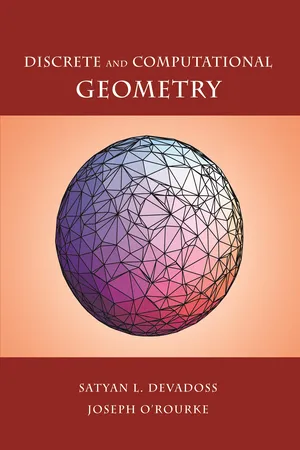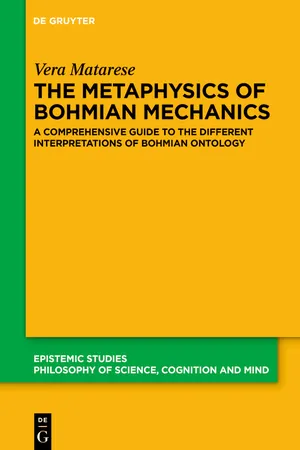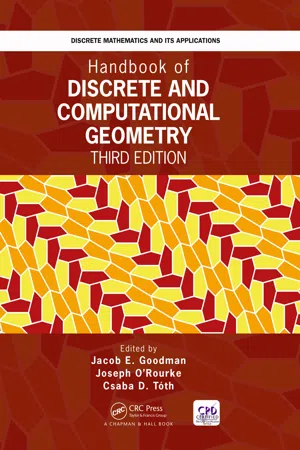Physics
Configuration Space
Configuration space is a mathematical space that represents all possible configurations of a physical system. It is used in physics to describe the position and orientation of objects in space. The configuration space of a system can be used to analyze its motion and behavior.
Written by Perlego with AI-assistance
Related key terms
Related key terms
1 of 4
Related key terms
1 of 3
3 Key excerpts on "Configuration Space"
- eBook - ePub
- Satyan L. Devadoss, Joseph O'Rourke(Authors)
- 2011(Publication Date)
- Princeton University Press(Publisher)
continuous Configuration Space. Here each point in this space corresponds to a particular, distinct configuration of the robots.The progression of the chapter is from more algorithmic concerns — whether a movement in Configuration Space between given positions is possible, and if so, how to realize the motion — to focus more on the topology and combinatorial structure of particular Configuration Spaces. A word on terminology. Although it is a crude simplification, physicists use state space , computer scientists use Configuration Space , and mathematicians use moduli space for the same concept. “State” emphasizes the status of a system determined by many perhaps disparate variables (such as temperature, pressure, and spin). “Configuration” suggests that geometric variables determine the object placement (such as translation coordinates and rotation angles). “Moduli” derives from “modulus,” which in this context means some abstract mathematical parameter. We will use Configuration Space throughout, as our examples are geometric, but the alternative terms are prevalent in the literature.We start our study of Configuration Spaces with a particularly simple motion planning problem: Find a path (if one exists) to move a single polygonal object R , without rotation, through the plane 2 littered with polygonal obstacles P 1 , P 2 , . . .,Pm. One can think of R as a wheeled robot moving through a floor plan with chairs, tables, and walls to avoid. (Later, we will incorporate rotation after analyzing translational motion.) This is one instance of a vast array of problems which we will only sample. Although we increase the complexity of our examples throughout this chapter, we will by no means exhaust the full range of possibilities.1 - eBook - ePub
The Metaphysics of Bohmian Mechanics
A Comprehensive Guide to the Different Interpretations of Bohmian Ontology
- Vera Matarese(Author)
- 2023(Publication Date)
- De Gruyter(Publisher)
. Each point of the Configuration Space represents a possible particle configuration, or, in other words, a possible ‘Q’: a possible arrangement of the different particle positions, while ℚ refers to a ‘possible’ but non-actual Q.We can suppose in our example that while the first particle position is, the second particle position isq 1= 2. These two positions in one-dimensional space are identified uniquely by a single point in ourq 2= 5R(our Configuration Space), as can be seen in Figure 2 .1 NFigure 2: A two-dimensional Configuration Space.We have also seen that the Bohmian particles move, following definite and continuous trajectories all the time. Given that we can represent all the particles’ positions of the universe with one single point in our Configuration Space, we can easily represent the trajectories of all the particles of the universe in our Configuration Space with one single trajectory by adding the axis for time.Note that we have not yet added any new elements that are not already present in classical mechanics. In classical mechanics as well, we have point-like particles moving along definite trajectories, and while they live in a three-dimensional space (our physical space), they can be represented as a single point in Configuration Space.1.2 The Wave-function
The second element of Bohmian mechanics, which demonstrates the quantum character of the theory, is the so-called ‘wave-function’:6Ψ xThe wave-function is a complex-valued function that maps each point of the Configuration Space, at each time, to a complex number. One can think of it as a decoration of our Configuration Space, or, more precisely, as a continuous distribution of complex numbers. The wave-function is defined for the whole Configuration Space, which means that it is defined for all possible points in the Configuration Space (all ‘x’s). Given that our space is three-dimensional, the Configuration Space is 3N-dimensional, and the wave-function has 3N degrees of freedom:7 - eBook - ePub
- Csaba D. Toth, Joseph O'Rourke, Jacob E. Goodman, Csaba D. Toth, Joseph O'Rourke, Jacob E. Goodman(Authors)
- 2017(Publication Date)
- Chapman and Hall/CRC(Publisher)
Terminology, axiomatics, and notation vary widely between authors. Note that the term “Configuration Space” is used in robotics with a different meaning (see Chapters 50 and 51). GLOSSARY index Configuration Space A four-tuple (X, T, D, K). X is a finite set of geometric objects (the universe of size n). T is a mapping that assigns to every subset S ⊆ X a set T (S) ; the elements of T (S) are called configurations. Π (X) : = ⋃ S ⊆ X T (S) is the set of all configurations occurring over some subset of X. D and K assign to every. configuration Δ ∈ Π (X) subsets D (Δ) and K (Δ) of X. Elements of the set D (Δ) are said to define the configuration (they are also called triggers) and the elements of the set K (Δ) are said to kill the configuration (they are also said to be in conflict with the configuration and are sometimes called stoppers). Conflict size of Δ The number of elements of K (Δ). We will require the following axioms: The number d = max { ‖ D (Δ) ‖ Δ ∈ Π (X) } is a constant (called the maximum degree or the dimension of the Configuration Space). Moreover, the number of configurations sharing the same defining set is bounded by a constant. For any Δ ∈ T (S), D (Δ) ⊆ S and S ∩ K (Δ) = ∅. If Δ ∈ T (S) and D (Δ) ⊆ S ′ ⊆ S, then Δ ∈ T (S ′). If D (Δ) ⊆ S and K (Δ) ∩ S = ∅, then Δ ∈ T (S). Note that axiom (iii) follows from. (iii ′); see below. EXAMPLES Trapezoidal map The universe X is a set of segments in the plane, and T (S) is the set of trapezoids in the trapezoidal map of S. The defining set D (Δ) is the set of segments that are necessary to define Δ (at most four segments suffice, so d = 4), and the killing set K (Δ) is the set of segments that intersect the trapezoid
Index pages curate the most relevant extracts from our library of academic textbooks. They’ve been created using an in-house natural language model (NLM), each adding context and meaning to key research topics.
Explore more topic indexes
Explore more topic indexes
1 of 6
Explore more topic indexes
1 of 4


